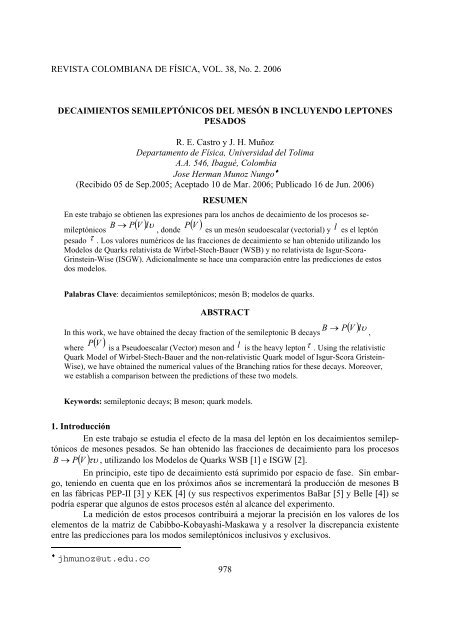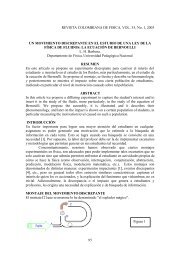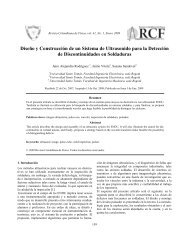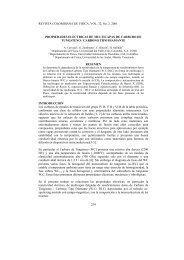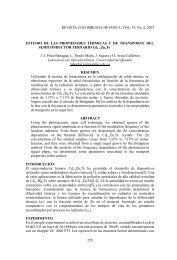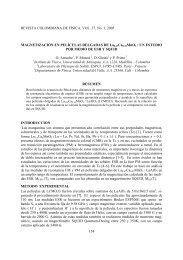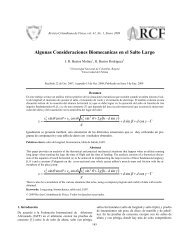( )υ ( ) ( )υ ( ) - Revista Colombiana de Física
( )υ ( ) ( )υ ( ) - Revista Colombiana de Física
( )υ ( ) ( )υ ( ) - Revista Colombiana de Física
Create successful ePaper yourself
Turn your PDF publications into a flip-book with our unique Google optimized e-Paper software.
REVISTA COLOMBIANA DE FÍSICA, VOL. 38, No. 2. 2006<br />
DECAIMIENTOS SEMILEPTÓNICOS DEL MESÓN B INCLUYENDO LEPTONES<br />
PESADOS<br />
R. E. Castro y J. H. Muñoz<br />
Departamento <strong>de</strong> <strong>Física</strong>, Universidad <strong>de</strong>l Tolima<br />
A.A. 546, Ibagué, Colombia<br />
Jose Herman Munoz Nungo ♦<br />
(Recibido 05 <strong>de</strong> Sep.2005; Aceptado 10 <strong>de</strong> Mar. 2006; Publicado 16 <strong>de</strong> Jun. 2006)<br />
RESUMEN<br />
En este trabajo se obtienen las expresiones para los anchos <strong>de</strong> <strong>de</strong>caimiento <strong>de</strong> los procesos se-<br />
B → P(<br />
V ) l<strong>υ</strong><br />
P(<br />
V )<br />
mileptónicos<br />
, don<strong>de</strong> es un mesón seudoescalar (vectorial) y l es el leptón<br />
pesado τ . Los valores numéricos <strong>de</strong> las fracciones <strong>de</strong> <strong>de</strong>caimiento se han obtenido utilizando los<br />
Mo<strong>de</strong>los <strong>de</strong> Quarks relativista <strong>de</strong> Wirbel-Stech-Bauer (WSB) y no relativista <strong>de</strong> Isgur-Scora-<br />
Grinstein-Wise (ISGW). Adicionalmente se hace una comparación entre las predicciones <strong>de</strong> estos<br />
dos mo<strong>de</strong>los.<br />
Palabras Clave: <strong>de</strong>caimientos semileptónicos; mesón B; mo<strong>de</strong>los <strong>de</strong> quarks.<br />
ABSTRACT<br />
B → P(<br />
V l )<strong>υ</strong><br />
In this work, we have obtained the <strong>de</strong>cay fraction of the semileptonic B <strong>de</strong>cays<br />
,<br />
P(<br />
V )<br />
where is a Pseudoescalar (Vector) meson and l is the heavy leptonτ . Using the relativistic<br />
Quark Mo<strong>de</strong>l of Wirbel-Stech-Bauer and the non-relativistic Quark mo<strong>de</strong>l of Isgur-Scora Gristein-<br />
Wise), we have obtained the numerical values of the Branching ratios for these <strong>de</strong>cays. Moreover,<br />
we establish a comparison between the predictions of these two mo<strong>de</strong>ls.<br />
Keywords: semileptonic <strong>de</strong>cays; B meson; quark mo<strong>de</strong>ls.<br />
1. Introducción<br />
En este trabajo se estudia el efecto <strong>de</strong> la masa <strong>de</strong>l leptón en los <strong>de</strong>caimientos semileptónicos<br />
<strong>de</strong> mesones pesados. Se han obtenido las fracciones <strong>de</strong> <strong>de</strong>caimiento para los procesos<br />
B → P(<br />
V )τ<strong>υ</strong>,<br />
utilizando los Mo<strong>de</strong>los <strong>de</strong> Quarks WSB [1] e ISGW [2].<br />
En principio, este tipo <strong>de</strong> <strong>de</strong>caimiento está suprimido por espacio <strong>de</strong> fase. Sin embargo,<br />
teniendo en cuenta que en los próximos años se incrementará la producción <strong>de</strong> mesones B<br />
en las fábricas PEP-II [3] y KEK [4] (y sus respectivos experimentos BaBar [5] y Belle [4]) se<br />
podría esperar que algunos <strong>de</strong> estos procesos estén al alcance <strong>de</strong>l experimento.<br />
La medición <strong>de</strong> estos procesos contribuirá a mejorar la precisión en los valores <strong>de</strong> los<br />
elementos <strong>de</strong> la matriz <strong>de</strong> Cabibbo-Kobayashi-Maskawa y a resolver la discrepancia existente<br />
entre las predicciones para los modos semileptónicos inclusivos y exclusivos.<br />
♦ jhmunoz@ut.edu.co<br />
978
REVISTA COLOMBIANA DE FÍSICA, VOL. 38, No. 2, 2006<br />
2. Resultados<br />
En esta sección se presentan las expresiones obtenidas para las fracciones <strong>de</strong> <strong>de</strong>caimiento <strong>de</strong> los<br />
procesos B → Pτ<strong>υ</strong><br />
B → Vτ<strong>υ</strong><br />
y , utilizando los Mo<strong>de</strong>los <strong>de</strong> Quarks WSB e ISGW para parametrizar<br />
la transición<br />
B → P(V<br />
)<br />
. Específicamente se obtienen en el Mo<strong>de</strong>lo WSB las ecuaciones<br />
(1) (ver por ejemplo [6]) y (3), y en el Mo<strong>de</strong>lo ISGW la ecuación (2):<br />
dΓ<br />
dt<br />
dΓ<br />
dt<br />
dΓ<br />
dt<br />
⎧ ⎡<br />
2<br />
2<br />
2<br />
2 3<br />
2 2 2<br />
⎪ 2 ⎛ t m τ ⎞ ⎛ 2t<br />
m τ ⎞ ⎤ ⎡<br />
2 3 ⎛ 2 t m<br />
( ) ( ) () ( m )<br />
2<br />
τ ⎞ B m P<br />
B Pτ<strong>υ</strong><br />
F t ⎢⎜<br />
−<br />
⎟ ⎜<br />
+<br />
⎟λ<br />
⎥ F t ⎢<br />
−<br />
m τ ⎜<br />
−<br />
→ =<br />
+<br />
⎟<br />
⎨<br />
⎪<br />
⎩<br />
V<br />
+<br />
2<br />
qb<br />
C<br />
⎢⎜<br />
⎣⎝<br />
3<br />
192π<br />
m<br />
V<br />
2 2<br />
K GF<br />
3<br />
B<br />
qb F 2<br />
( B → Pτ<strong>υ</strong>)<br />
= ( F () t<br />
192π<br />
m<br />
+ F<br />
2<br />
−<br />
2<br />
G<br />
3<br />
⎡<br />
3<br />
⎢2<br />
⎣<br />
2<br />
3<br />
B<br />
t<br />
,<br />
+<br />
⎟ ⎜<br />
⎠ ⎝<br />
t − m<br />
t<br />
2 2<br />
2t<br />
⎡⎛<br />
⎢⎜<br />
t − m<br />
⎢⎜<br />
⎣⎝<br />
t<br />
2<br />
τ<br />
1<br />
⎤<br />
2<br />
⎟<br />
⎠<br />
⎥<br />
⎦<br />
⎞ ⎛<br />
⎟ ⎜<br />
2t<br />
+ m<br />
⎟ ⎜<br />
⎠ ⎝ 2t<br />
979<br />
0<br />
2<br />
τ<br />
⎢2<br />
⎣<br />
⎞<br />
⎟<br />
3<br />
λ + m<br />
⎟<br />
⎠ 2<br />
⎜<br />
⎝<br />
t<br />
⎟<br />
⎠<br />
t<br />
2<br />
2 2 ( m − m )<br />
() ⎢ 2 ( τ ) 2 ⎥<br />
2<br />
2 2<br />
() () ⎢3<br />
⎜ τ<br />
t m λ + F t F t m ⎟ ( m − m ) λ2<br />
⎥).<br />
2<br />
2<br />
V<br />
2 2<br />
qb GF<br />
( ) ( t − ml<br />
) A2<br />
() t<br />
B → Vl<strong>υ</strong><br />
= (<br />
192π<br />
m<br />
+<br />
−<br />
+ 3<br />
τ<br />
⎥<br />
⎦<br />
+<br />
( m + m )<br />
−<br />
⎡<br />
⎢<br />
⎣<br />
3<br />
2<br />
τ<br />
2<br />
τ<br />
⎛ t − m<br />
⎜<br />
⎝ t<br />
⎛<br />
⎜<br />
t − m<br />
⎜<br />
⎝ t<br />
2<br />
2<br />
⎞<br />
⎟<br />
⎠<br />
2<br />
τ<br />
5<br />
2 3 2 2 2 2<br />
( t + 2m<br />
) λ2<br />
− m ( t − 2m<br />
t − 2m<br />
t)<br />
2<br />
2 2<br />
3<br />
( t − ml<br />
)( mB<br />
+ m ) A1<br />
( t)<br />
⎛<br />
V ⎜ 4<br />
2 2 4 2<br />
( t − 2m<br />
) λ2<br />
+ 6t(<br />
2m<br />
t − m m )<br />
2 ( t − ml<br />
) A1()<br />
t A2<br />
() t 2 4 2 2 2 2 2 2<br />
( ( t − m )( m − m − t)<br />
+ m ( t − 2tm<br />
+ 2tm<br />
)<br />
+<br />
t<br />
B<br />
2<br />
⎞<br />
⎟<br />
⎠<br />
p<br />
B<br />
t<br />
1<br />
⎤<br />
⎥<br />
⎦<br />
p<br />
1 ⎤⎫<br />
λ2<br />
⎥⎪<br />
⎬<br />
⎥<br />
⎦⎪<br />
⎭<br />
2<br />
1 ⎤<br />
λ2<br />
⎥<br />
⎥<br />
⎦<br />
4 2 2 6 6 2 2 4 2 4 2 4 2 2<br />
ml<br />
( mB<br />
t − mB<br />
+ mV<br />
+ mV<br />
t − 3mB<br />
mV<br />
+ 4mV<br />
t − 3mB<br />
mV<br />
+ 4mV<br />
mB<br />
t)<br />
2 2<br />
3<br />
1<br />
( t − m ) V () t ⎛<br />
⎞<br />
l ⎜ 2 4 2<br />
4 2 2 4 4<br />
( 2t<br />
− m − m t)<br />
λ2<br />
− 6m<br />
( 2m<br />
m − m − m ) λ2<br />
⎟<br />
2<br />
2<br />
3<br />
12ml<br />
+<br />
2t<br />
m<br />
4t<br />
m<br />
4t<br />
m<br />
( m + m )<br />
B<br />
2<br />
3<br />
B<br />
3 2<br />
V<br />
3 2<br />
V<br />
3 2<br />
V<br />
2<br />
2 ( m + m ) A () t V () t<br />
B<br />
V<br />
t<br />
⎜<br />
⎝<br />
V<br />
1<br />
B<br />
l<br />
V<br />
⎜<br />
⎝<br />
l<br />
2<br />
λ<br />
l<br />
1<br />
2<br />
B<br />
) ,<br />
V qb<br />
don<strong>de</strong>: es el elemento <strong>de</strong> matriz CKM correspondiente,<br />
C K ≈ 1<br />
es el coeficiente <strong>de</strong><br />
Clebsh-Jordan,<br />
GF<br />
−5<br />
= 1.<br />
166 × 10<br />
GeV-2,<br />
mτ es la masa <strong>de</strong>l tau y λ es la función <strong>de</strong> Euler<br />
4 4 2 2 2 2 2<br />
λ = m B + m P + t − 2m Bt<br />
− 2m<br />
Pt<br />
− 2m<br />
Bm<br />
P .<br />
l<br />
l<br />
V<br />
l<br />
2<br />
V<br />
B<br />
l<br />
l<br />
V<br />
l<br />
B<br />
V<br />
V<br />
B<br />
1 ⎞<br />
λ2<br />
⎟<br />
⎟<br />
⎠<br />
V<br />
B<br />
B<br />
λ<br />
λ<br />
⎟<br />
⎠<br />
1<br />
2<br />
3<br />
2<br />
(1)<br />
(2)<br />
1<br />
2<br />
λ )<br />
() 3
REVISTA COLOMBIANA DE FÍSICA, VOL. 38, No. 2. 2006<br />
Si<br />
ml<br />
= 0<br />
()<br />
en (1) ó (2), solamente aparece el término proporcional a<br />
F + t<br />
. Se pue<strong>de</strong><br />
( )<br />
observar que en (1) aparece un término proporcional a<br />
F0 t 1 2<br />
y λ . A<strong>de</strong>más no hay contribu-<br />
( ) ( )<br />
ción proporcional al producto<br />
F 0 t F+<br />
t<br />
. En (2), aparecen dos términos adicionales proporcio-<br />
()<br />
nales a<br />
F− t<br />
( ) ( )<br />
y al producto<br />
F+ t F−<br />
t<br />
. Si<br />
ml<br />
= 0<br />
en (3), <strong>de</strong>saparece el término proporcional al<br />
1<br />
() ()<br />
producto<br />
A1 t V t 2<br />
y λ ( ) ( )<br />
. No hay término proporcional al producto<br />
A2 t V t<br />
en ninguno <strong>de</strong><br />
los dos casos.<br />
Con las expresiones anteriores y los siguientes valores numéricos se obtienen las frac-<br />
m − = m 0 = 5.<br />
279 GeV<br />
ciones <strong>de</strong> <strong>de</strong>caimiento mostradas en las tablas 1 y 2: B B<br />
−2<br />
−2<br />
m = 1.<br />
77 GeV , V = 4.<br />
12×<br />
10 , V = 3.<br />
6×<br />
10 , 0 = 5.<br />
369 GeV , − = 6.<br />
4 GeV ,<br />
τ<br />
mu d<br />
cb<br />
ub<br />
980<br />
m<br />
Bs<br />
m<br />
Bc<br />
= m = 0.<br />
33GeV<br />
, = 1.<br />
82 GeV , τ − = 1.<br />
67 × 10 s , τ 0 = 1.<br />
54 × 10 s ,<br />
m c<br />
τ 0 = 1.<br />
46 × 10 s y τ − = 4.<br />
6 × 10 s .<br />
B<br />
s<br />
−12<br />
B<br />
c<br />
−11<br />
Tabla No.1. Fracciones <strong>de</strong> <strong>de</strong>caimiento para canales exclusivos<br />
B<br />
B → Pl<strong>υ</strong><br />
−<br />
0<br />
→ π l<strong>υ</strong><br />
B → ηl<strong>υ</strong><br />
−<br />
−<br />
B → η′ l<strong>υ</strong><br />
B<br />
B<br />
−<br />
0<br />
0<br />
→ D l<strong>υ</strong><br />
+<br />
→ π l<strong>υ</strong><br />
FRACCIONES DE DECAIMIENTO CON<br />
8×<br />
10<br />
4.<br />
4 × 10<br />
1.<br />
7 × 10<br />
2.<br />
3×<br />
10<br />
1.<br />
4 × 10<br />
m<br />
= 0<br />
l<br />
WSB ISGW ISGW2<br />
−5<br />
−5<br />
−5<br />
−5<br />
−2<br />
−4<br />
−2<br />
2.<br />
2 × 10<br />
2.<br />
8×<br />
10<br />
2.<br />
1×<br />
10<br />
3.<br />
2 × 10<br />
0.<br />
4 × 10<br />
−4<br />
−5<br />
−2<br />
−4<br />
−2<br />
B<br />
1.<br />
3×<br />
10<br />
1.<br />
5×<br />
10<br />
−3<br />
−4<br />
2.<br />
5×<br />
10<br />
4.<br />
2 × 10<br />
2.<br />
3×<br />
10<br />
−4<br />
−2<br />
−3<br />
−12<br />
B<br />
B → Pl<strong>υ</strong><br />
.<br />
−12<br />
FRACCIONES DE DECAIMIENTO CON<br />
6 × 10<br />
3×<br />
10<br />
1×<br />
10<br />
ml = m<br />
τ<br />
WSB ISGW ISGW2<br />
−5<br />
−5<br />
−5<br />
−5<br />
0.<br />
7 × 10<br />
1.<br />
1×<br />
10<br />
−2<br />
−4<br />
1.<br />
7 × 10<br />
0.<br />
8×<br />
10<br />
0.<br />
6 × 10<br />
0.<br />
8×<br />
10<br />
0.<br />
3×<br />
10<br />
−5<br />
−5<br />
−2<br />
−4<br />
6 × 10<br />
4 × 10<br />
−4<br />
−4<br />
0.<br />
7 × 10<br />
1×<br />
10<br />
−2<br />
1.<br />
1×<br />
10<br />
0 +<br />
B → D l<strong>υ</strong><br />
2.<br />
1×<br />
10 2.<br />
9 × 10 7.<br />
2 × 10 0.<br />
6 × 10 0.<br />
7 × 10 0.<br />
1×<br />
10<br />
De la tabla 1 se pue<strong>de</strong>n hacer algunas observaciones: (i) El valor experimental<br />
−<br />
<strong>de</strong> la fracción <strong>de</strong> <strong>de</strong>caimiento para B<br />
0<br />
−5<br />
→ π l<strong>υ</strong><br />
(l=e) es 9 × 10 [8]. El mo<strong>de</strong>lo ISGW2 predi-<br />
−<br />
ce un valor mayor; (ii) Para B<br />
0<br />
→ D l<strong>υ</strong><br />
nuestra predicción coinci<strong>de</strong> con el reportado en [9]<br />
(usando HQET); (iii) En general, las predicciones obtenidas en el Mo<strong>de</strong>lo ISGW2 son mayores.<br />
Tabla No.2. Fracciones <strong>de</strong> <strong>de</strong>caimiento para canales exclusivos B → Vl<strong>υ</strong><br />
.<br />
B → Vl<strong>υ</strong><br />
FRACCIONES DE DE-<br />
CAIMIENTO CON<br />
ml = 0 GeV<br />
WSB<br />
B<br />
−<br />
0<br />
→ ρ l<strong>υ</strong><br />
2.<br />
8×<br />
10<br />
−4<br />
−2<br />
−2<br />
FRACCIONES DE DECAI-<br />
MIENTO CON<br />
ml = mτ<br />
= 1.<br />
77GeV<br />
WSB<br />
0.<br />
9 × 10<br />
−4<br />
−2<br />
DATO<br />
EXP.<br />
l=e,µ<br />
1.<br />
34 ×<br />
10<br />
−5<br />
−3<br />
−2<br />
−4
B → ωl<strong>υ</strong><br />
−<br />
B<br />
B<br />
B<br />
Bs<br />
− →<br />
0<br />
0<br />
0<br />
−<br />
Bc D<br />
∗0<br />
+<br />
l<strong>υ</strong><br />
→ ρ l<strong>υ</strong><br />
→ D<br />
∗+<br />
→ Ds<br />
l<strong>υ</strong><br />
∗+<br />
l<strong>υ</strong><br />
→ J / ψl<strong>υ</strong><br />
REVISTA COLOMBIANA DE FÍSICA, VOL. 38, No. 2, 2006<br />
1.<br />
8×<br />
10<br />
1×<br />
10<br />
−4<br />
−2<br />
5.<br />
16 × 10<br />
5.<br />
74 × 10<br />
1×<br />
10<br />
−2<br />
2.<br />
25×<br />
10<br />
−4<br />
−2<br />
−2<br />
981<br />
0.<br />
62 × 10<br />
0.<br />
92 × 10<br />
1.<br />
66 × 10<br />
5×<br />
10<br />
−2<br />
0.<br />
88×<br />
10<br />
−4<br />
−2<br />
−4<br />
−2<br />
−2<br />
2.<br />
1×<br />
10<br />
5.<br />
3×<br />
10<br />
−4<br />
−2<br />
2.<br />
6 × 10<br />
4.<br />
6 × 10<br />
7.<br />
9 × 10<br />
2.<br />
24 × 10<br />
< 5.<br />
2 × 10<br />
De la tabla 2 po<strong>de</strong>mos ver lo siguiente: (i) El valor <strong>de</strong> la fracción <strong>de</strong> <strong>de</strong>caimiento <strong>de</strong><br />
− 0<br />
B → ρ l<strong>υ</strong><br />
coinci<strong>de</strong> con la literatura [9], con l = e,<br />
µ . Cuando l = τ este valor se reduce a la<br />
tercera parte aproximadamente, acercándose al valor experimental. (ii) La fracción <strong>de</strong> <strong>de</strong>cai-<br />
−<br />
miento para Bc → J / ψl<strong>υ</strong><br />
se reduce solo <strong>de</strong> 2.25% con l = e,<br />
µ a 2.24% con l = τ . En [10]<br />
aparece 1.7% con l = µ y 0.8% con l = τ . (iii) El valor <strong>de</strong> la fracción <strong>de</strong> <strong>de</strong>caimiento para<br />
0<br />
∗+<br />
B → D l<strong>υ</strong><br />
es 5.74% con l = e,<br />
µ y 5% con l = τ . En [11] aparece 5%. (iv) En los procesos<br />
en los que la masa <strong>de</strong>l hadrón en el estado final sea mayor, la diferencia entre los valores <strong>de</strong> las<br />
columnas 2 y 3 es menor. (v) En general, los valores <strong>de</strong> las fracciones <strong>de</strong> <strong>de</strong>caimiento son menores<br />
cuando se utiliza la masa <strong>de</strong>l tau, que cuando m = 0 .<br />
3. Conclusiones: Se calcularon las fracciones <strong>de</strong> <strong>de</strong>caimiento <strong>de</strong> los procesos semileptónicos<br />
<strong>de</strong>l B consi<strong>de</strong>rando la masa <strong>de</strong>l tau con mesones pseudoescalares y vectoriales en el estado<br />
final, usando los Mo<strong>de</strong>los <strong>de</strong> Quarks relativista WSB [1] y no relativista ISGW [2]. Las fracciones<br />
<strong>de</strong> <strong>de</strong>caimiento utilizando el tau son menores que cuando se hace cero la masa <strong>de</strong>l leptón.<br />
En el Mo<strong>de</strong>lo WSB se obtienen valores más cercanos a los experimentales.<br />
4. Agra<strong>de</strong>cimientos: Los autores expresan agra<strong>de</strong>cen a la Oficina <strong>de</strong> Investigaciones <strong>de</strong> la<br />
Universidad <strong>de</strong>l Tolima por la financiación <strong>de</strong>l presente trabajo.<br />
Referencias<br />
[1] M. Wirbel, B. Stech and M. Bauer, Z. Phys. C 29, 637 (1985); M. Bauer and<br />
M. Wirbel, Z. Phys. C 42, 671 (1989).<br />
[2] N. Isgur, D. Scora, B. Grinstein and M. B. Wise, Phys. Rev. D 39, 799<br />
(1989); D. Scora and N. Isgur, Phys. Rev. D 52, 2783 (1995).<br />
[3] http://www.slac.stanford.edu/accel/peppi/home.htlm<br />
[4] http://www.kek.jp/<br />
[5] The BaBar Physics Book, P. F. Harrison and H. R. Quinn (eds.), (1998).<br />
[6] G. Lopez Castro, Int. Jour. Mod. Phys. 6 18 (1991).<br />
[7] K. Kiers and A. Soni. Phys. Rev. D 56, 5786 (1997).<br />
[8] Particle Data Group, S Ei<strong>de</strong>lman et al, Phys. Lett. B 592 I (2004).<br />
[9] G. H. Wu, K. Kiers and J. N. Ng. Phys. Rev. D 56 (1997).<br />
[10]S. Stone. HEPSY 96-01, e-print hep-ph/9610305.<br />
[11] A. Y. Anisimov, P. Y. Kulinov, I. M. Naro<strong>de</strong>stkii and K. A. Ter-Martirosyan. Phys. Atom. Nucl. 62,<br />
1739 (1999).<br />
l<br />
−4<br />
−2<br />
−2<br />
−5


